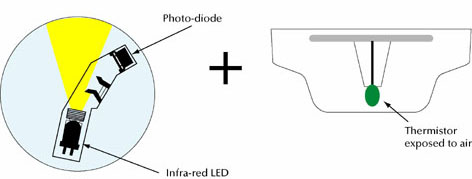|
Integrating ionisation smoke detector
Available in the
Series 60 and
Series 65
ranges, this type of detector works on the same principles as
the ionisation smoke detector, but has modified signal
processing circuitry which allows an alarm threshold to be
present for up to 20 seconds without initiating an alarm.
This type of detector is suitable for use in
areas where transient high levels of smoke may be expected.
Integrating effect in analogue addressable systems
In
XP95
systems, the integrating effect can be mimicked in both
ionisation and optical smoke detectors by adjusting the
control equipment software to cause an appropriate delay.
Discovery
smoke detectors should be set to Mode 2 or Mode 4 to achieve
this effect. Click
here
to find out more.
Optical (photo-electric)
smoke detector
Optical smoke
detectors incorporate a pulsing infra-red LED located in a
chamber within the housing of the detector. The chamber is
designed to exclude light from any external source. At an
angle to the LED is a photo-diode which normally does not
register the column of light emitted by the LED. In the event
of smoke from a fire entering the chamber, the light pulse
from the LED will be scattered and hence registered by the
photo-diode. If the photo-diode "sees" smoke on the two
following pulses, the detector changes into alarm state and
the indicator LED lights up. The detector housing is identical
to that of the ionisation detector but has an indicator LED
which is clear in quiescent state but produces red light in
alarm.
Optical smoke detectors respond particularly
well to slow-burning (smouldering) fires. They are widely used
for life protection.

Heat detector
Most
conventional heat detectors (all Series 60 and
Series 65
&
AlarmSense
A1R, BR and CR) operate by using a matched pair of thermistors
to sense heat. One thermistor is exposed to the ambient
temperature, the other is sealed. In normal conditions the two
thermistors register similar temperatures, but, on the
development of a fire, the temperature recorded by the exposed
thermistor will increase rapidly, resulting in an imbalance of
the thermistors, causing the detector to change into alarm
state. Rate-of-rise detectors are designed to detect a fire as
the temperature increases, but they also have a fixed upper
limit at which the detector will go into alarm if the rate of
temperature increase has been too slow to trigger the detector
earlier.
The Series 65
and AlarmSense CS (static response) heat detectors have only
one thermistor. They change to the alarm state at a preset
temperature.
Externally, the heat detectors are
distinguishable from the smoke detectors by having wide
openings to the surrounding atmosphere to allow good movement
of air around the external thermistor.
A heat detector may be more appropriate than a
smoke detector where the environment is dirty or smoky under
normal conditions. It must be recognised, however, that any
heat detector will respond only when a fire is well
established and generating a high heat output.

Multisensor detector
Available in
the
XP95
and
Discovery
ranges, this type of detector is basically an optical smoke
detector - so it will respond well to smouldering fires. The
addition of a heat sensing element allows the multi-sensor to
give a response to fast burning (flaming) fires which is
comparable to that of an ionisation detector.
Multisensor detectors are general purpose
detectors which respond well to a wide range of fires.

Carbon Monoxide (CO) detector
Carbon Monoxide (CO) is a poisonous gas produced by combustion
and a CO fire detector is used to indicate the outbreak of a
fire by sensing the level of CO in the air. The detector has
an electrochemical cell which senses CO, but not smoke or
other combustion products. The cells do not require much power,
so the detector can be made electrically compatible with
ordinary smoke and heat detectors. Apollo manufacturers a CO
detector as part of the
Discovery
range.
CO detectors are particuarly good at detecting
deep-seated, smouldering fires.
To find out
more, visit the
CO Detectors
page.
Beam detector
A beam detector is
designed to protect large, open spaces and is made up of three
main parts: the transmitter, which projects a beam of infra-red
light; the receiver which registers the light and produces an
electrical signal; and the interface, which processes the
signal and generates alarm or fault signals. When a fire
develops, smoke particles obstruct the beam of light and, once
a pre-set threshold has been exceeded, the detector will go
into alarm.
To find out
more, visit the
XP95 Beam Detector
page.
Flame detector
A flame
detector is designed to detect either ultraviolet (UV) or
infra-red (IR) radiation emitted by a fire. The XP95
Dual IR flame detector
is sensitive to low-frequency, flickering infra-red radiation.
This means that the detector can operate even if the lens is
contaminated by a layer of oil, dust, water vapour or ice.
Flame detectors are
effective in protecting areas where flaming fires may be
expected.
To find out
more, visit the XP95
Dual IR Flame Detector
page.
Relative performance of Apollo
detectors in test fire
|
Type of
detector |
|
Type of
combustion | |
|
|
|
|
|
|
Overheating/thermal |
poor |
very good |
very good |
very poor |
very poor |
|
Smouldering/glowing |
moderate/good |
good |
good |
very poor |
excellent |
|
Flaming |
very good |
good |
good |
poor |
poor |
|
Flaming with high
heat output |
very good |
good
|
very good |
moderate/good |
moderate |
|
Flaming - clean
burning |
poor |
very poor |
moderate/good |
moderate/good |
very poor |
For
definitions of terms used within the fire detection industry,
visit the
Glossary.
|